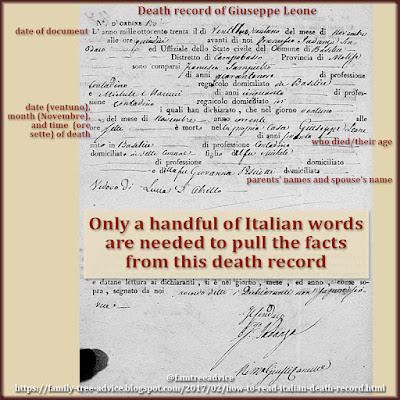Last year I paid for a copy of my grandfather's 1992 Bronx, NY, death certificate because my brother, my first cousins and I wanted to be sure of his cause of death for our own health records.
When it arrived I was surprised and disappointed that it did not include his cause of death.
 |
| My grandfather's death certificate. |
I had seen many New York City death certificates while doing research at the New York City Municipal Archives, but they were from decades earlier. I don't know if my grandpa's certificate was abbreviated because he died less than 25 years ago, or if that is what the Bronx death certificate form looked like in 1992.
So I've gone through my records and compared death records from four decades—three certificates from the Bronx and one from Warren, Ohio, near Youngstown.
The following table compares the 27 pieces of information found in different years. These certificates can be an amazing find if you didn't already know every little fact.
| 1925 Bronx, NY | 1940 Bronx, NY | 1970 Warren, OH | 1992 Bronx, NY |
|---|---|---|---|
| Full name, sex and age | Full name, sex and age | Full name, sex and age | Full name, sex and age |
| Race | Race | Race | |
| Place of death and characterization of place (e.g., hospital, hotel) | Place of death and if it’s a hospital or institution | Place of death and if it’s a hospital or institution | Place of death; if in a hospital, date of admission |
| Date of death | Date of death | Date of death | Date of death |
| Time of death | Time of death | ||
| Attending physician and dates tending to the deceased | Attending physician and dates tending to the deceased | Attending physician and dates tending to the deceased | Attending physician and dates tending to the deceased |
| Primary and secondary cause of death | Primary and secondary cause of death | Primary and secondary cause of death | |
| Last residence | Last residence | Last residence | Last residence |
| Marital status | Marital status | Marital status | Marital status |
| Name of surviving spouse | Name of surviving spouse (maiden name if wife) | Name of surviving spouse (maiden name if wife) | |
| Date of birth | Date of birth | Date of birth | Date of birth |
| Social Security Number | Social Security Number | ||
| Occupation | Occupation | Occupation | Occupation |
| Whether served in armed forces | Whether served in armed forces | ||
| Date last worked at occupation | |||
| Birthplace | Birthplace | Birthplace | Birthplace |
| Citizen of what country | |||
| How long in U.S. if foreign born | How long in U.S. if foreign born | ||
| How long resident in City of New York | How long resident in City of New York | ||
| Level of education | |||
| Parents' names | Parents' names | Parents' names | Parents' names |
| Parents’ birthplaces | Parents’ birthplaces | ||
| Name of informant, relationship to deceased, and address | Name of informant, relationship to deceased, and address | Name of informant, relationship to deceased, and address | |
| Autopsy and laboratory tests dates | Autopsy | ||
| Name and location of cemetery | Name and location of cemetery | Name and location of cemetery | Name and location of cemetery |
| Date of burial | Date of burial or cremation | Date of burial or cremation | Date of burial or cremation |
| Funeral director's name and address | Funeral director's name and address | Funeral director's name and address | Funeral director's name and address |
Are you scouring your ancestor's death certificate for every possible scrap of information?









